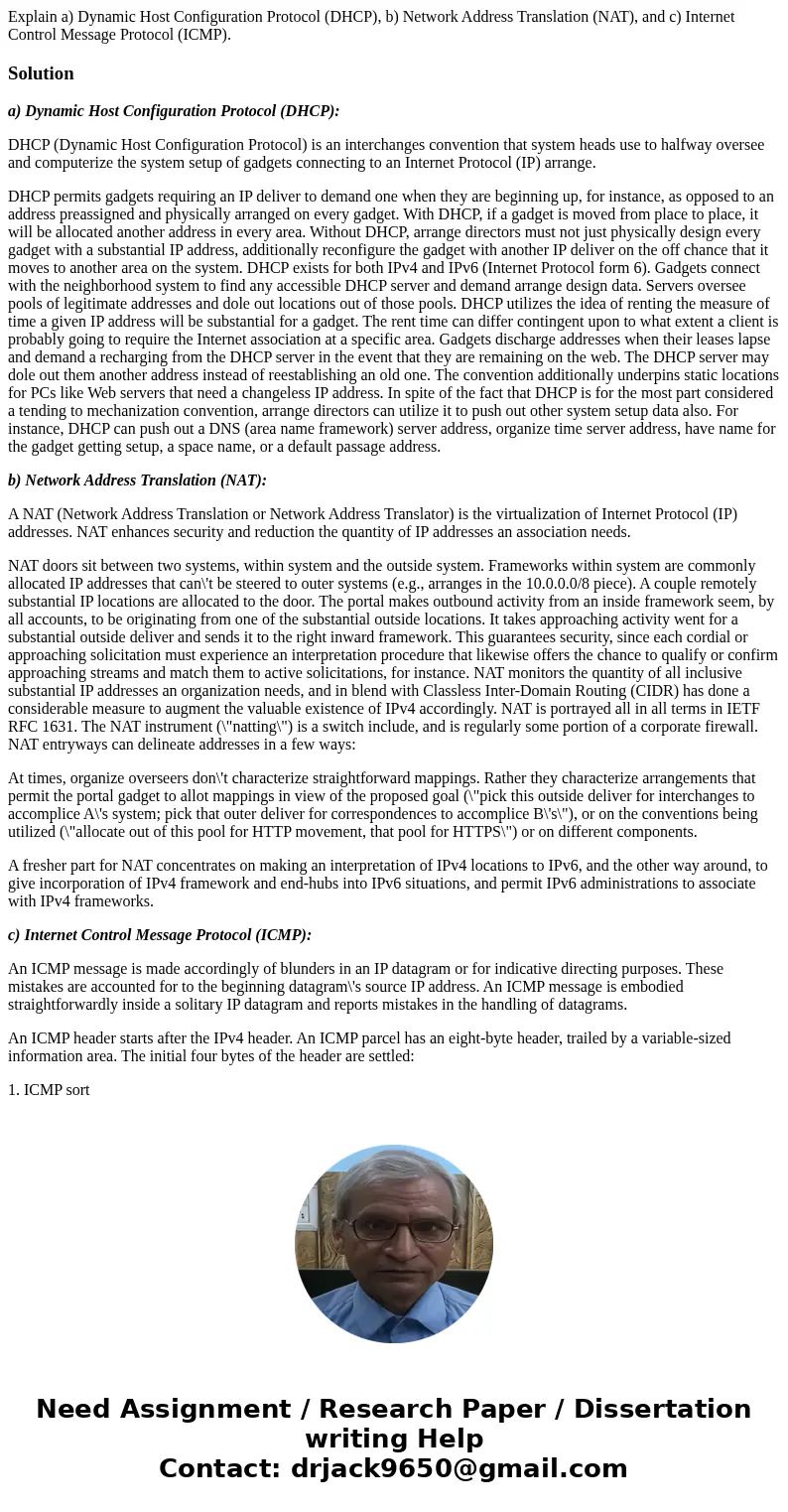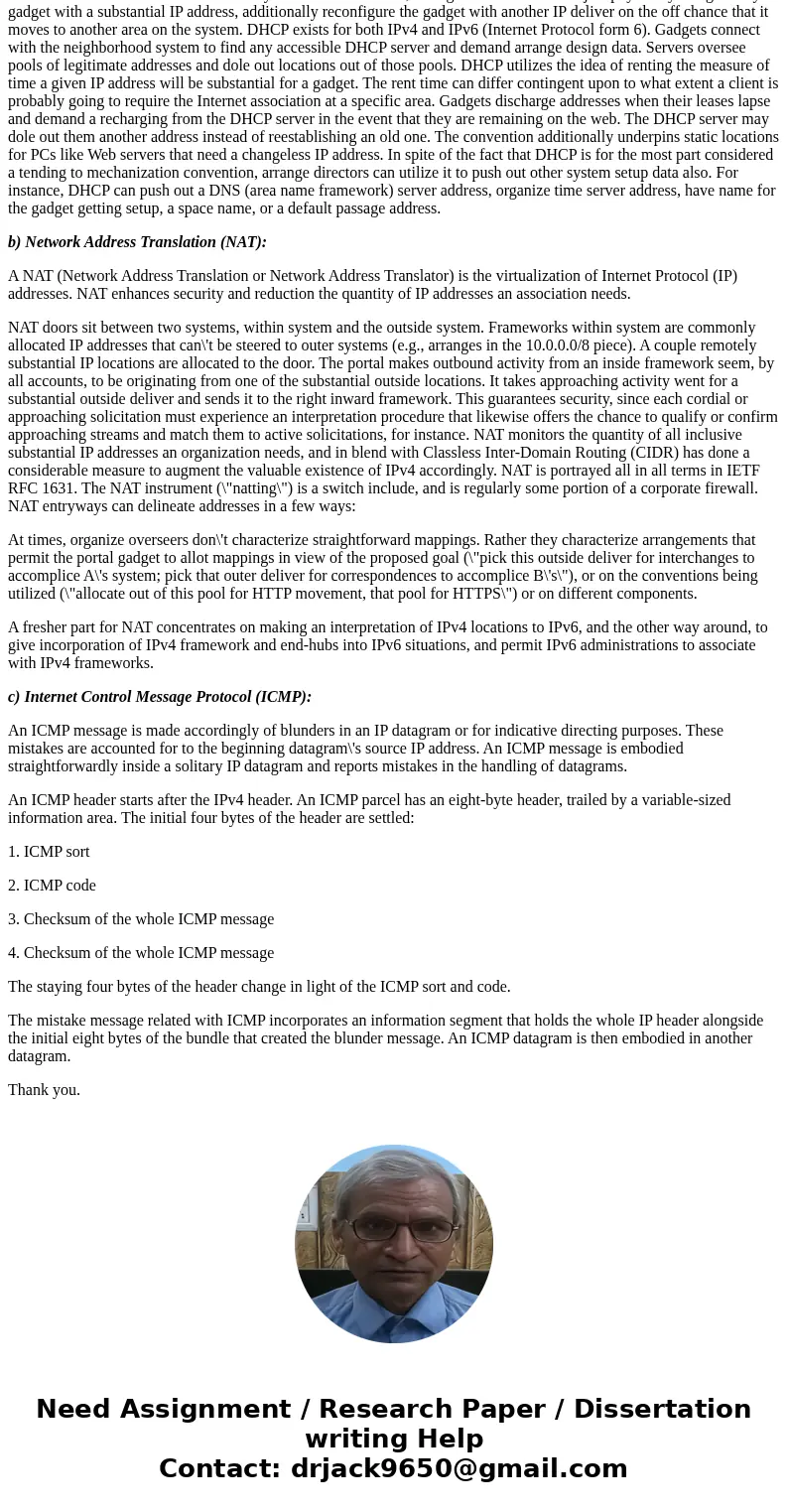Explain a Dynamic Host Configuration Protocol DHCP b Network
Explain a) Dynamic Host Configuration Protocol (DHCP), b) Network Address Translation (NAT), and c) Internet Control Message Protocol (ICMP).
Solution
a) Dynamic Host Configuration Protocol (DHCP):
DHCP (Dynamic Host Configuration Protocol) is an interchanges convention that system heads use to halfway oversee and computerize the system setup of gadgets connecting to an Internet Protocol (IP) arrange.
DHCP permits gadgets requiring an IP deliver to demand one when they are beginning up, for instance, as opposed to an address preassigned and physically arranged on every gadget. With DHCP, if a gadget is moved from place to place, it will be allocated another address in every area. Without DHCP, arrange directors must not just physically design every gadget with a substantial IP address, additionally reconfigure the gadget with another IP deliver on the off chance that it moves to another area on the system. DHCP exists for both IPv4 and IPv6 (Internet Protocol form 6). Gadgets connect with the neighborhood system to find any accessible DHCP server and demand arrange design data. Servers oversee pools of legitimate addresses and dole out locations out of those pools. DHCP utilizes the idea of renting the measure of time a given IP address will be substantial for a gadget. The rent time can differ contingent upon to what extent a client is probably going to require the Internet association at a specific area. Gadgets discharge addresses when their leases lapse and demand a recharging from the DHCP server in the event that they are remaining on the web. The DHCP server may dole out them another address instead of reestablishing an old one. The convention additionally underpins static locations for PCs like Web servers that need a changeless IP address. In spite of the fact that DHCP is for the most part considered a tending to mechanization convention, arrange directors can utilize it to push out other system setup data also. For instance, DHCP can push out a DNS (area name framework) server address, organize time server address, have name for the gadget getting setup, a space name, or a default passage address.
b) Network Address Translation (NAT):
A NAT (Network Address Translation or Network Address Translator) is the virtualization of Internet Protocol (IP) addresses. NAT enhances security and reduction the quantity of IP addresses an association needs.
NAT doors sit between two systems, within system and the outside system. Frameworks within system are commonly allocated IP addresses that can\'t be steered to outer systems (e.g., arranges in the 10.0.0.0/8 piece). A couple remotely substantial IP locations are allocated to the door. The portal makes outbound activity from an inside framework seem, by all accounts, to be originating from one of the substantial outside locations. It takes approaching activity went for a substantial outside deliver and sends it to the right inward framework. This guarantees security, since each cordial or approaching solicitation must experience an interpretation procedure that likewise offers the chance to qualify or confirm approaching streams and match them to active solicitations, for instance. NAT monitors the quantity of all inclusive substantial IP addresses an organization needs, and in blend with Classless Inter-Domain Routing (CIDR) has done a considerable measure to augment the valuable existence of IPv4 accordingly. NAT is portrayed all in all terms in IETF RFC 1631. The NAT instrument (\"natting\") is a switch include, and is regularly some portion of a corporate firewall. NAT entryways can delineate addresses in a few ways:
At times, organize overseers don\'t characterize straightforward mappings. Rather they characterize arrangements that permit the portal gadget to allot mappings in view of the proposed goal (\"pick this outside deliver for interchanges to accomplice A\'s system; pick that outer deliver for correspondences to accomplice B\'s\"), or on the conventions being utilized (\"allocate out of this pool for HTTP movement, that pool for HTTPS\") or on different components.
A fresher part for NAT concentrates on making an interpretation of IPv4 locations to IPv6, and the other way around, to give incorporation of IPv4 framework and end-hubs into IPv6 situations, and permit IPv6 administrations to associate with IPv4 frameworks.
c) Internet Control Message Protocol (ICMP):
An ICMP message is made accordingly of blunders in an IP datagram or for indicative directing purposes. These mistakes are accounted for to the beginning datagram\'s source IP address. An ICMP message is embodied straightforwardly inside a solitary IP datagram and reports mistakes in the handling of datagrams.
An ICMP header starts after the IPv4 header. An ICMP parcel has an eight-byte header, trailed by a variable-sized information area. The initial four bytes of the header are settled:
1. ICMP sort
2. ICMP code
3. Checksum of the whole ICMP message
4. Checksum of the whole ICMP message
The staying four bytes of the header change in light of the ICMP sort and code.
The mistake message related with ICMP incorporates an information segment that holds the whole IP header alongside the initial eight bytes of the bundle that created the blunder message. An ICMP datagram is then embodied in another datagram.
Thank you.


 Homework Sourse
Homework Sourse